Advanced Financial Accounting Report: Ansell Ltd Case Study Analysis
VerifiedAdded on 2022/11/13
|12
|3275
|484
Report
AI Summary
This report provides an executive summary and detailed analysis of Ansell Ltd's financial accounting practices. It begins with an introduction to the company, its operations, and its four business segments. The report then delves into the accounting concepts used, including objectivity, matching, consistency, and revenue recognition, highlighting Ansell Ltd's adherence to AASB 15. It explores measurement issues, using examples like historical cost, and discusses the importance of relevance and representational faithfulness in financial reporting. The report emphasizes the need for accurate and transparent financial statements to aid investor decision-making. The analysis covers the application of accounting principles, measurement challenges, and the importance of relevance and faithful representation in the financial statements of Ansell Ltd. The report concludes by summarizing the key findings and the importance of accurate financial reporting.

ADVANCED FINANCIAL ACCOUNTING
Paraphrase This Document
Need a fresh take? Get an instant paraphrase of this document with our AI Paraphraser

Ansell Ltd
Executive Summary
Accounting information plays a pivotal part in shaping the destiny of the organization.
Hence, it is important that the accounting concepts be carefully analyzed by the end users so
that a complete understanding be done. To conduct this report, Ansell Ltd has been selected
and the same is studied in the light of various parameters such as accounting concept,
measurement, and relevance.
2
Executive Summary
Accounting information plays a pivotal part in shaping the destiny of the organization.
Hence, it is important that the accounting concepts be carefully analyzed by the end users so
that a complete understanding be done. To conduct this report, Ansell Ltd has been selected
and the same is studied in the light of various parameters such as accounting concept,
measurement, and relevance.
2
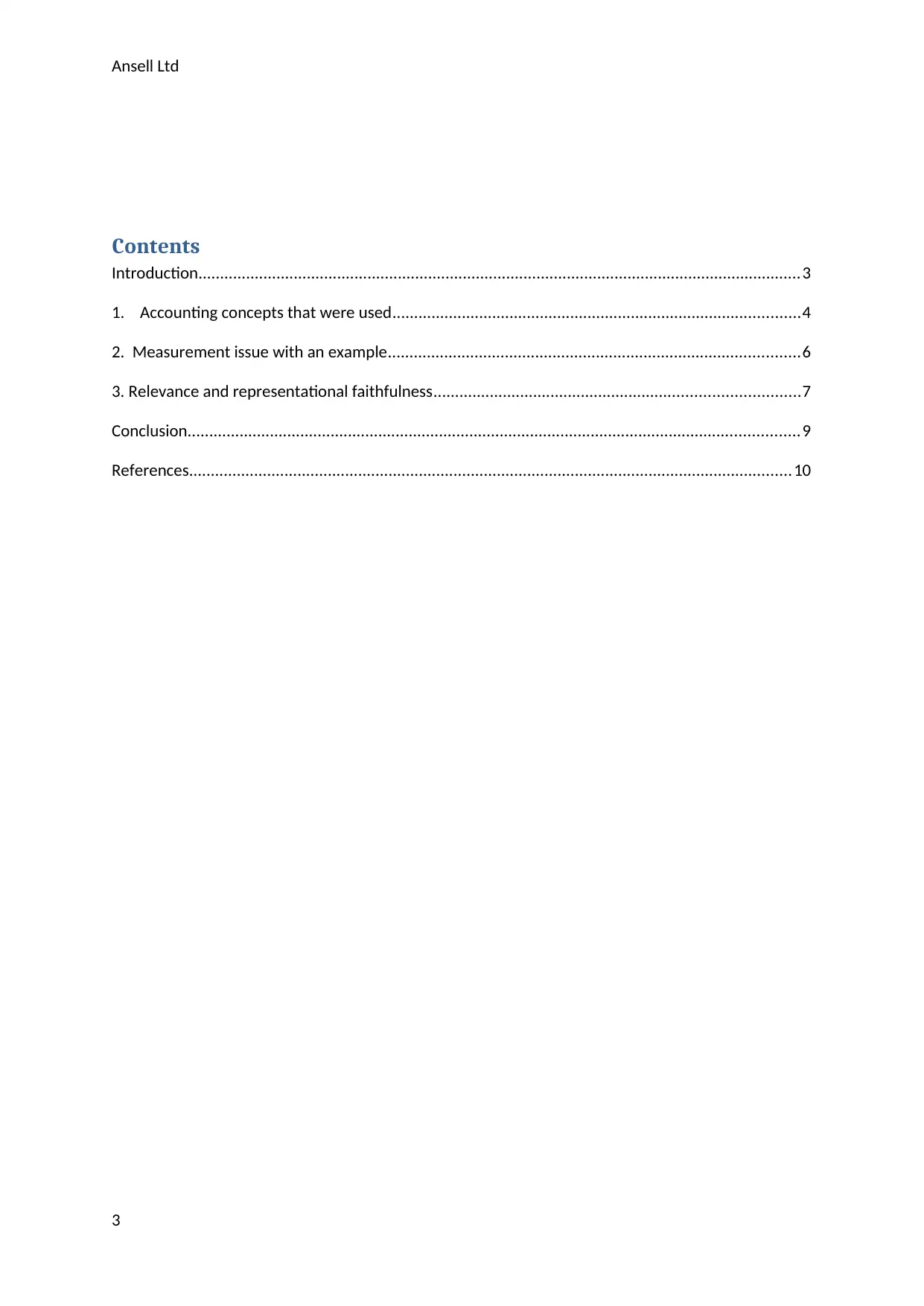
Ansell Ltd
Contents
Introduction...........................................................................................................................................3
1. Accounting concepts that were used..............................................................................................4
2. Measurement issue with an example...............................................................................................6
3. Relevance and representational faithfulness....................................................................................7
Conclusion.............................................................................................................................................9
References...........................................................................................................................................10
3
Contents
Introduction...........................................................................................................................................3
1. Accounting concepts that were used..............................................................................................4
2. Measurement issue with an example...............................................................................................6
3. Relevance and representational faithfulness....................................................................................7
Conclusion.............................................................................................................................................9
References...........................................................................................................................................10
3
⊘ This is a preview!⊘
Do you want full access?
Subscribe today to unlock all pages.

Trusted by 1+ million students worldwide
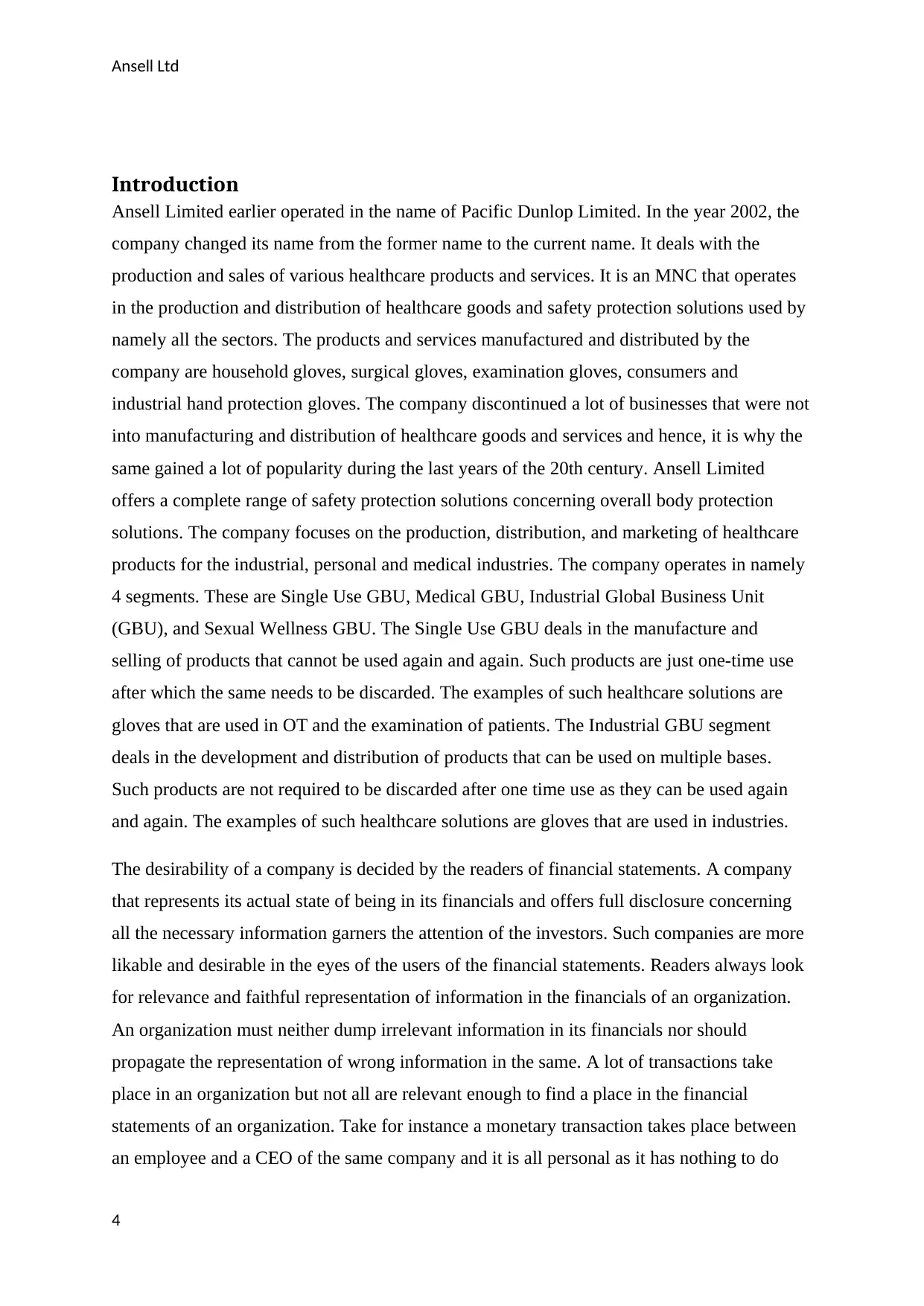
Ansell Ltd
Introduction
Ansell Limited earlier operated in the name of Pacific Dunlop Limited. In the year 2002, the
company changed its name from the former name to the current name. It deals with the
production and sales of various healthcare products and services. It is an MNC that operates
in the production and distribution of healthcare goods and safety protection solutions used by
namely all the sectors. The products and services manufactured and distributed by the
company are household gloves, surgical gloves, examination gloves, consumers and
industrial hand protection gloves. The company discontinued a lot of businesses that were not
into manufacturing and distribution of healthcare goods and services and hence, it is why the
same gained a lot of popularity during the last years of the 20th century. Ansell Limited
offers a complete range of safety protection solutions concerning overall body protection
solutions. The company focuses on the production, distribution, and marketing of healthcare
products for the industrial, personal and medical industries. The company operates in namely
4 segments. These are Single Use GBU, Medical GBU, Industrial Global Business Unit
(GBU), and Sexual Wellness GBU. The Single Use GBU deals in the manufacture and
selling of products that cannot be used again and again. Such products are just one-time use
after which the same needs to be discarded. The examples of such healthcare solutions are
gloves that are used in OT and the examination of patients. The Industrial GBU segment
deals in the development and distribution of products that can be used on multiple bases.
Such products are not required to be discarded after one time use as they can be used again
and again. The examples of such healthcare solutions are gloves that are used in industries.
The desirability of a company is decided by the readers of financial statements. A company
that represents its actual state of being in its financials and offers full disclosure concerning
all the necessary information garners the attention of the investors. Such companies are more
likable and desirable in the eyes of the users of the financial statements. Readers always look
for relevance and faithful representation of information in the financials of an organization.
An organization must neither dump irrelevant information in its financials nor should
propagate the representation of wrong information in the same. A lot of transactions take
place in an organization but not all are relevant enough to find a place in the financial
statements of an organization. Take for instance a monetary transaction takes place between
an employee and a CEO of the same company and it is all personal as it has nothing to do
4
Introduction
Ansell Limited earlier operated in the name of Pacific Dunlop Limited. In the year 2002, the
company changed its name from the former name to the current name. It deals with the
production and sales of various healthcare products and services. It is an MNC that operates
in the production and distribution of healthcare goods and safety protection solutions used by
namely all the sectors. The products and services manufactured and distributed by the
company are household gloves, surgical gloves, examination gloves, consumers and
industrial hand protection gloves. The company discontinued a lot of businesses that were not
into manufacturing and distribution of healthcare goods and services and hence, it is why the
same gained a lot of popularity during the last years of the 20th century. Ansell Limited
offers a complete range of safety protection solutions concerning overall body protection
solutions. The company focuses on the production, distribution, and marketing of healthcare
products for the industrial, personal and medical industries. The company operates in namely
4 segments. These are Single Use GBU, Medical GBU, Industrial Global Business Unit
(GBU), and Sexual Wellness GBU. The Single Use GBU deals in the manufacture and
selling of products that cannot be used again and again. Such products are just one-time use
after which the same needs to be discarded. The examples of such healthcare solutions are
gloves that are used in OT and the examination of patients. The Industrial GBU segment
deals in the development and distribution of products that can be used on multiple bases.
Such products are not required to be discarded after one time use as they can be used again
and again. The examples of such healthcare solutions are gloves that are used in industries.
The desirability of a company is decided by the readers of financial statements. A company
that represents its actual state of being in its financials and offers full disclosure concerning
all the necessary information garners the attention of the investors. Such companies are more
likable and desirable in the eyes of the users of the financial statements. Readers always look
for relevance and faithful representation of information in the financials of an organization.
An organization must neither dump irrelevant information in its financials nor should
propagate the representation of wrong information in the same. A lot of transactions take
place in an organization but not all are relevant enough to find a place in the financial
statements of an organization. Take for instance a monetary transaction takes place between
an employee and a CEO of the same company and it is all personal as it has nothing to do
4
Paraphrase This Document
Need a fresh take? Get an instant paraphrase of this document with our AI Paraphraser
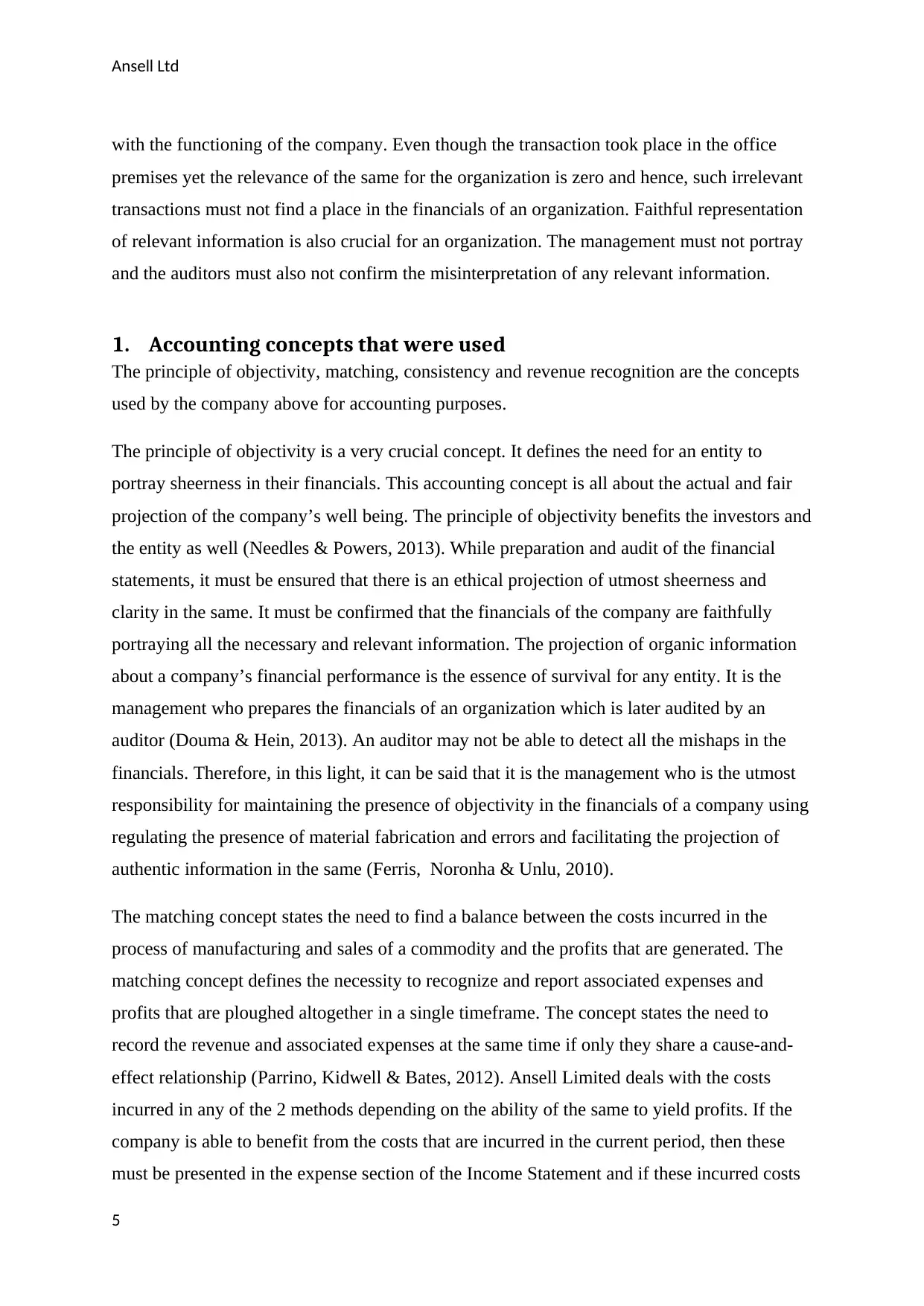
Ansell Ltd
with the functioning of the company. Even though the transaction took place in the office
premises yet the relevance of the same for the organization is zero and hence, such irrelevant
transactions must not find a place in the financials of an organization. Faithful representation
of relevant information is also crucial for an organization. The management must not portray
and the auditors must also not confirm the misinterpretation of any relevant information.
1. Accounting concepts that were used
The principle of objectivity, matching, consistency and revenue recognition are the concepts
used by the company above for accounting purposes.
The principle of objectivity is a very crucial concept. It defines the need for an entity to
portray sheerness in their financials. This accounting concept is all about the actual and fair
projection of the company’s well being. The principle of objectivity benefits the investors and
the entity as well (Needles & Powers, 2013). While preparation and audit of the financial
statements, it must be ensured that there is an ethical projection of utmost sheerness and
clarity in the same. It must be confirmed that the financials of the company are faithfully
portraying all the necessary and relevant information. The projection of organic information
about a company’s financial performance is the essence of survival for any entity. It is the
management who prepares the financials of an organization which is later audited by an
auditor (Douma & Hein, 2013). An auditor may not be able to detect all the mishaps in the
financials. Therefore, in this light, it can be said that it is the management who is the utmost
responsibility for maintaining the presence of objectivity in the financials of a company using
regulating the presence of material fabrication and errors and facilitating the projection of
authentic information in the same (Ferris, Noronha & Unlu, 2010).
The matching concept states the need to find a balance between the costs incurred in the
process of manufacturing and sales of a commodity and the profits that are generated. The
matching concept defines the necessity to recognize and report associated expenses and
profits that are ploughed altogether in a single timeframe. The concept states the need to
record the revenue and associated expenses at the same time if only they share a cause-and-
effect relationship (Parrino, Kidwell & Bates, 2012). Ansell Limited deals with the costs
incurred in any of the 2 methods depending on the ability of the same to yield profits. If the
company is able to benefit from the costs that are incurred in the current period, then these
must be presented in the expense section of the Income Statement and if these incurred costs
5
with the functioning of the company. Even though the transaction took place in the office
premises yet the relevance of the same for the organization is zero and hence, such irrelevant
transactions must not find a place in the financials of an organization. Faithful representation
of relevant information is also crucial for an organization. The management must not portray
and the auditors must also not confirm the misinterpretation of any relevant information.
1. Accounting concepts that were used
The principle of objectivity, matching, consistency and revenue recognition are the concepts
used by the company above for accounting purposes.
The principle of objectivity is a very crucial concept. It defines the need for an entity to
portray sheerness in their financials. This accounting concept is all about the actual and fair
projection of the company’s well being. The principle of objectivity benefits the investors and
the entity as well (Needles & Powers, 2013). While preparation and audit of the financial
statements, it must be ensured that there is an ethical projection of utmost sheerness and
clarity in the same. It must be confirmed that the financials of the company are faithfully
portraying all the necessary and relevant information. The projection of organic information
about a company’s financial performance is the essence of survival for any entity. It is the
management who prepares the financials of an organization which is later audited by an
auditor (Douma & Hein, 2013). An auditor may not be able to detect all the mishaps in the
financials. Therefore, in this light, it can be said that it is the management who is the utmost
responsibility for maintaining the presence of objectivity in the financials of a company using
regulating the presence of material fabrication and errors and facilitating the projection of
authentic information in the same (Ferris, Noronha & Unlu, 2010).
The matching concept states the need to find a balance between the costs incurred in the
process of manufacturing and sales of a commodity and the profits that are generated. The
matching concept defines the necessity to recognize and report associated expenses and
profits that are ploughed altogether in a single timeframe. The concept states the need to
record the revenue and associated expenses at the same time if only they share a cause-and-
effect relationship (Parrino, Kidwell & Bates, 2012). Ansell Limited deals with the costs
incurred in any of the 2 methods depending on the ability of the same to yield profits. If the
company is able to benefit from the costs that are incurred in the current period, then these
must be presented in the expense section of the Income Statement and if these incurred costs
5
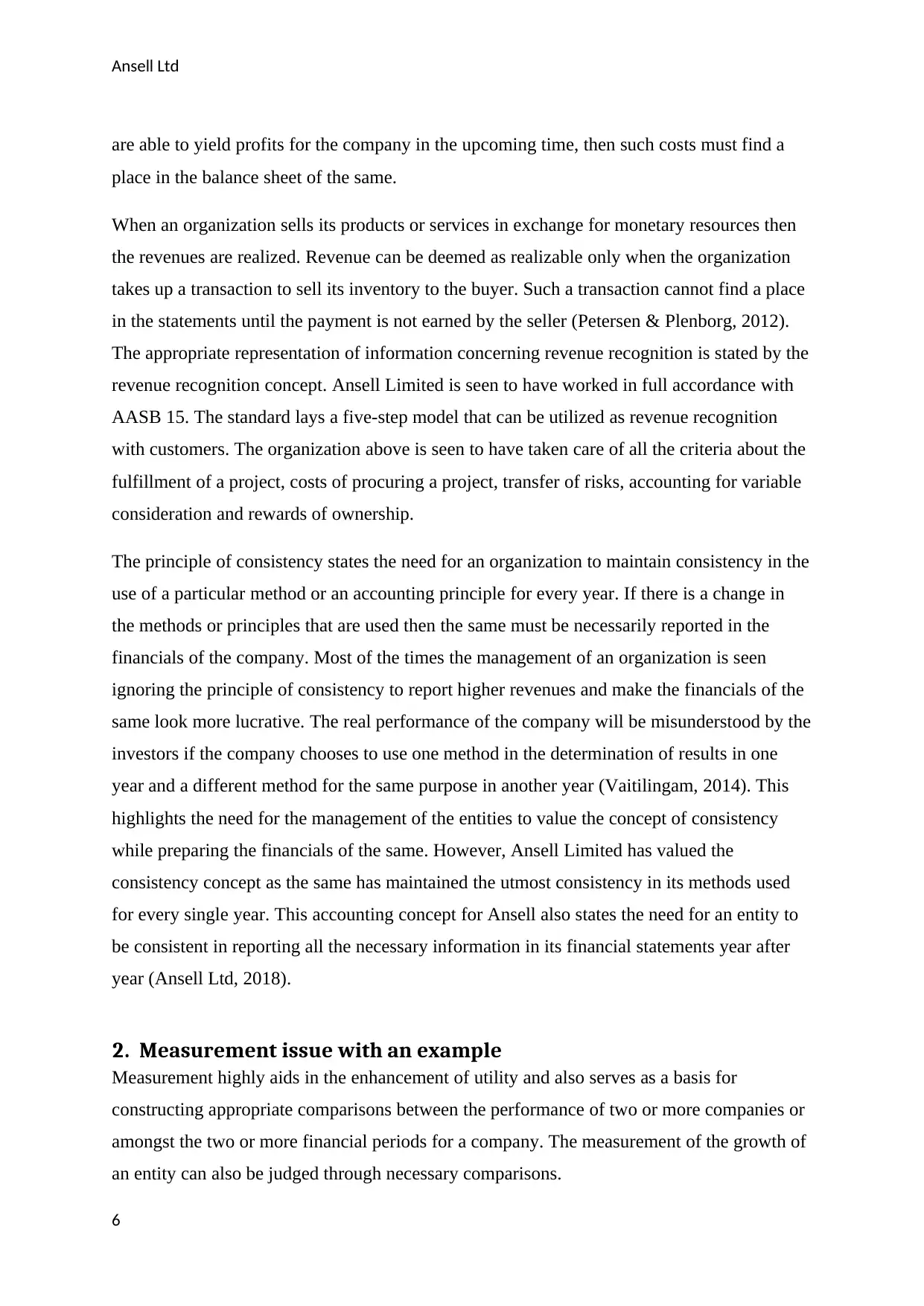
Ansell Ltd
are able to yield profits for the company in the upcoming time, then such costs must find a
place in the balance sheet of the same.
When an organization sells its products or services in exchange for monetary resources then
the revenues are realized. Revenue can be deemed as realizable only when the organization
takes up a transaction to sell its inventory to the buyer. Such a transaction cannot find a place
in the statements until the payment is not earned by the seller (Petersen & Plenborg, 2012).
The appropriate representation of information concerning revenue recognition is stated by the
revenue recognition concept. Ansell Limited is seen to have worked in full accordance with
AASB 15. The standard lays a five-step model that can be utilized as revenue recognition
with customers. The organization above is seen to have taken care of all the criteria about the
fulfillment of a project, costs of procuring a project, transfer of risks, accounting for variable
consideration and rewards of ownership.
The principle of consistency states the need for an organization to maintain consistency in the
use of a particular method or an accounting principle for every year. If there is a change in
the methods or principles that are used then the same must be necessarily reported in the
financials of the company. Most of the times the management of an organization is seen
ignoring the principle of consistency to report higher revenues and make the financials of the
same look more lucrative. The real performance of the company will be misunderstood by the
investors if the company chooses to use one method in the determination of results in one
year and a different method for the same purpose in another year (Vaitilingam, 2014). This
highlights the need for the management of the entities to value the concept of consistency
while preparing the financials of the same. However, Ansell Limited has valued the
consistency concept as the same has maintained the utmost consistency in its methods used
for every single year. This accounting concept for Ansell also states the need for an entity to
be consistent in reporting all the necessary information in its financial statements year after
year (Ansell Ltd, 2018).
2. Measurement issue with an example
Measurement highly aids in the enhancement of utility and also serves as a basis for
constructing appropriate comparisons between the performance of two or more companies or
amongst the two or more financial periods for a company. The measurement of the growth of
an entity can also be judged through necessary comparisons.
6
are able to yield profits for the company in the upcoming time, then such costs must find a
place in the balance sheet of the same.
When an organization sells its products or services in exchange for monetary resources then
the revenues are realized. Revenue can be deemed as realizable only when the organization
takes up a transaction to sell its inventory to the buyer. Such a transaction cannot find a place
in the statements until the payment is not earned by the seller (Petersen & Plenborg, 2012).
The appropriate representation of information concerning revenue recognition is stated by the
revenue recognition concept. Ansell Limited is seen to have worked in full accordance with
AASB 15. The standard lays a five-step model that can be utilized as revenue recognition
with customers. The organization above is seen to have taken care of all the criteria about the
fulfillment of a project, costs of procuring a project, transfer of risks, accounting for variable
consideration and rewards of ownership.
The principle of consistency states the need for an organization to maintain consistency in the
use of a particular method or an accounting principle for every year. If there is a change in
the methods or principles that are used then the same must be necessarily reported in the
financials of the company. Most of the times the management of an organization is seen
ignoring the principle of consistency to report higher revenues and make the financials of the
same look more lucrative. The real performance of the company will be misunderstood by the
investors if the company chooses to use one method in the determination of results in one
year and a different method for the same purpose in another year (Vaitilingam, 2014). This
highlights the need for the management of the entities to value the concept of consistency
while preparing the financials of the same. However, Ansell Limited has valued the
consistency concept as the same has maintained the utmost consistency in its methods used
for every single year. This accounting concept for Ansell also states the need for an entity to
be consistent in reporting all the necessary information in its financial statements year after
year (Ansell Ltd, 2018).
2. Measurement issue with an example
Measurement highly aids in the enhancement of utility and also serves as a basis for
constructing appropriate comparisons between the performance of two or more companies or
amongst the two or more financial periods for a company. The measurement of the growth of
an entity can also be judged through necessary comparisons.
6
⊘ This is a preview!⊘
Do you want full access?
Subscribe today to unlock all pages.

Trusted by 1+ million students worldwide
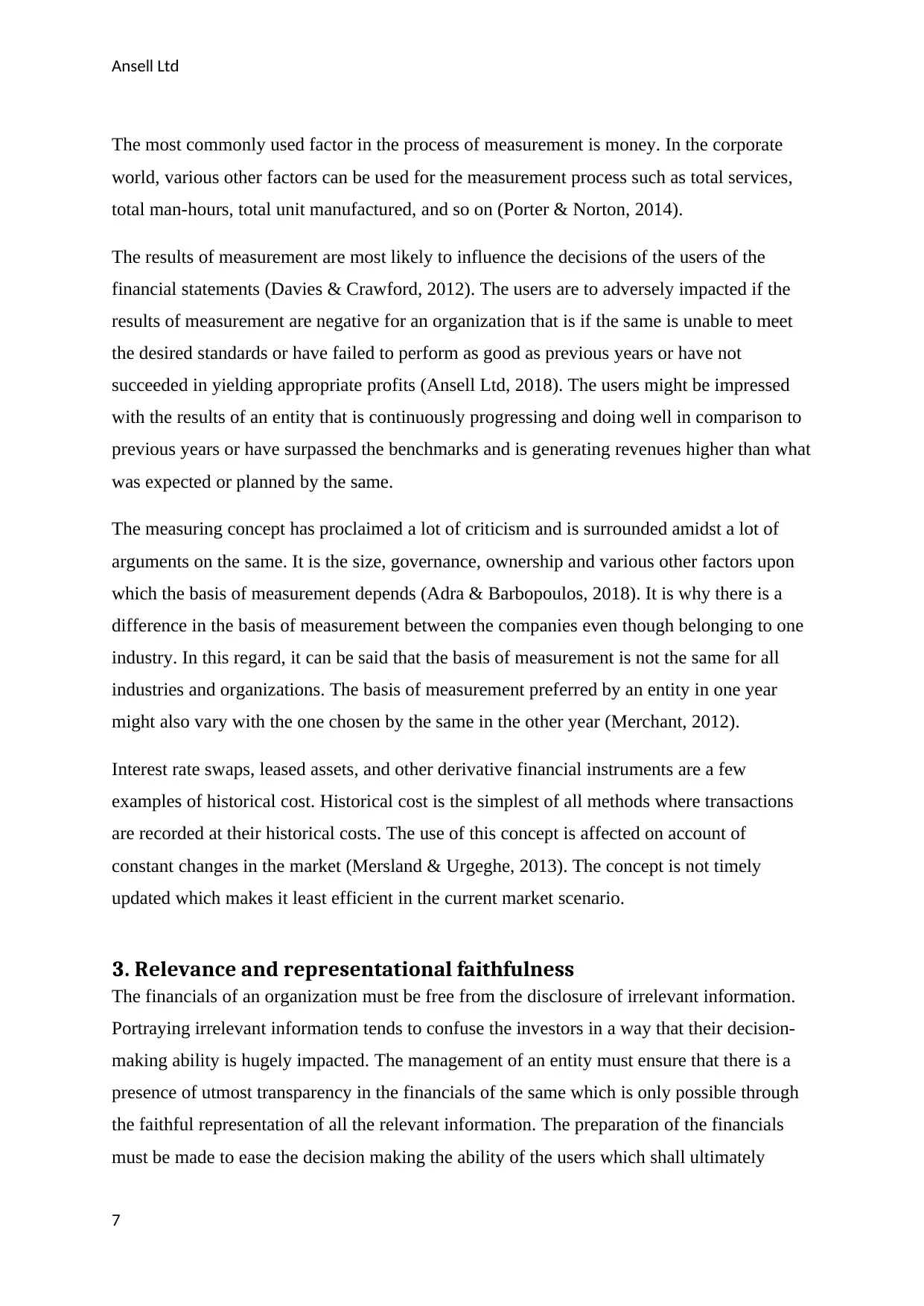
Ansell Ltd
The most commonly used factor in the process of measurement is money. In the corporate
world, various other factors can be used for the measurement process such as total services,
total man-hours, total unit manufactured, and so on (Porter & Norton, 2014).
The results of measurement are most likely to influence the decisions of the users of the
financial statements (Davies & Crawford, 2012). The users are to adversely impacted if the
results of measurement are negative for an organization that is if the same is unable to meet
the desired standards or have failed to perform as good as previous years or have not
succeeded in yielding appropriate profits (Ansell Ltd, 2018). The users might be impressed
with the results of an entity that is continuously progressing and doing well in comparison to
previous years or have surpassed the benchmarks and is generating revenues higher than what
was expected or planned by the same.
The measuring concept has proclaimed a lot of criticism and is surrounded amidst a lot of
arguments on the same. It is the size, governance, ownership and various other factors upon
which the basis of measurement depends (Adra & Barbopoulos, 2018). It is why there is a
difference in the basis of measurement between the companies even though belonging to one
industry. In this regard, it can be said that the basis of measurement is not the same for all
industries and organizations. The basis of measurement preferred by an entity in one year
might also vary with the one chosen by the same in the other year (Merchant, 2012).
Interest rate swaps, leased assets, and other derivative financial instruments are a few
examples of historical cost. Historical cost is the simplest of all methods where transactions
are recorded at their historical costs. The use of this concept is affected on account of
constant changes in the market (Mersland & Urgeghe, 2013). The concept is not timely
updated which makes it least efficient in the current market scenario.
3. Relevance and representational faithfulness
The financials of an organization must be free from the disclosure of irrelevant information.
Portraying irrelevant information tends to confuse the investors in a way that their decision-
making ability is hugely impacted. The management of an entity must ensure that there is a
presence of utmost transparency in the financials of the same which is only possible through
the faithful representation of all the relevant information. The preparation of the financials
must be made to ease the decision making the ability of the users which shall ultimately
7
The most commonly used factor in the process of measurement is money. In the corporate
world, various other factors can be used for the measurement process such as total services,
total man-hours, total unit manufactured, and so on (Porter & Norton, 2014).
The results of measurement are most likely to influence the decisions of the users of the
financial statements (Davies & Crawford, 2012). The users are to adversely impacted if the
results of measurement are negative for an organization that is if the same is unable to meet
the desired standards or have failed to perform as good as previous years or have not
succeeded in yielding appropriate profits (Ansell Ltd, 2018). The users might be impressed
with the results of an entity that is continuously progressing and doing well in comparison to
previous years or have surpassed the benchmarks and is generating revenues higher than what
was expected or planned by the same.
The measuring concept has proclaimed a lot of criticism and is surrounded amidst a lot of
arguments on the same. It is the size, governance, ownership and various other factors upon
which the basis of measurement depends (Adra & Barbopoulos, 2018). It is why there is a
difference in the basis of measurement between the companies even though belonging to one
industry. In this regard, it can be said that the basis of measurement is not the same for all
industries and organizations. The basis of measurement preferred by an entity in one year
might also vary with the one chosen by the same in the other year (Merchant, 2012).
Interest rate swaps, leased assets, and other derivative financial instruments are a few
examples of historical cost. Historical cost is the simplest of all methods where transactions
are recorded at their historical costs. The use of this concept is affected on account of
constant changes in the market (Mersland & Urgeghe, 2013). The concept is not timely
updated which makes it least efficient in the current market scenario.
3. Relevance and representational faithfulness
The financials of an organization must be free from the disclosure of irrelevant information.
Portraying irrelevant information tends to confuse the investors in a way that their decision-
making ability is hugely impacted. The management of an entity must ensure that there is a
presence of utmost transparency in the financials of the same which is only possible through
the faithful representation of all the relevant information. The preparation of the financials
must be made to ease the decision making the ability of the users which shall ultimately
7
Paraphrase This Document
Need a fresh take? Get an instant paraphrase of this document with our AI Paraphraser
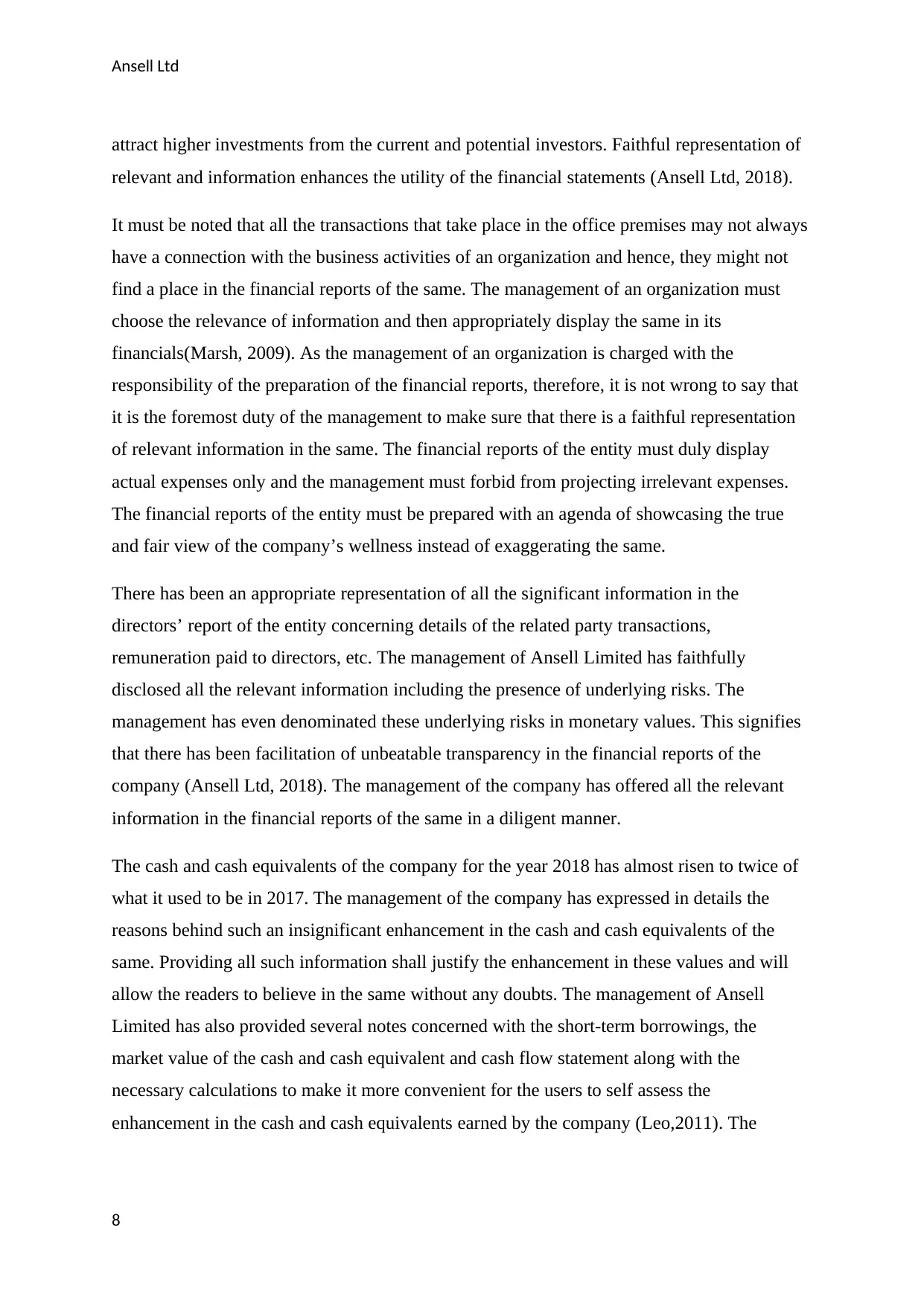
Ansell Ltd
attract higher investments from the current and potential investors. Faithful representation of
relevant and information enhances the utility of the financial statements (Ansell Ltd, 2018).
It must be noted that all the transactions that take place in the office premises may not always
have a connection with the business activities of an organization and hence, they might not
find a place in the financial reports of the same. The management of an organization must
choose the relevance of information and then appropriately display the same in its
financials(Marsh, 2009). As the management of an organization is charged with the
responsibility of the preparation of the financial reports, therefore, it is not wrong to say that
it is the foremost duty of the management to make sure that there is a faithful representation
of relevant information in the same. The financial reports of the entity must duly display
actual expenses only and the management must forbid from projecting irrelevant expenses.
The financial reports of the entity must be prepared with an agenda of showcasing the true
and fair view of the company’s wellness instead of exaggerating the same.
There has been an appropriate representation of all the significant information in the
directors’ report of the entity concerning details of the related party transactions,
remuneration paid to directors, etc. The management of Ansell Limited has faithfully
disclosed all the relevant information including the presence of underlying risks. The
management has even denominated these underlying risks in monetary values. This signifies
that there has been facilitation of unbeatable transparency in the financial reports of the
company (Ansell Ltd, 2018). The management of the company has offered all the relevant
information in the financial reports of the same in a diligent manner.
The cash and cash equivalents of the company for the year 2018 has almost risen to twice of
what it used to be in 2017. The management of the company has expressed in details the
reasons behind such an insignificant enhancement in the cash and cash equivalents of the
same. Providing all such information shall justify the enhancement in these values and will
allow the readers to believe in the same without any doubts. The management of Ansell
Limited has also provided several notes concerned with the short-term borrowings, the
market value of the cash and cash equivalent and cash flow statement along with the
necessary calculations to make it more convenient for the users to self assess the
enhancement in the cash and cash equivalents earned by the company (Leo,2011). The
8
attract higher investments from the current and potential investors. Faithful representation of
relevant and information enhances the utility of the financial statements (Ansell Ltd, 2018).
It must be noted that all the transactions that take place in the office premises may not always
have a connection with the business activities of an organization and hence, they might not
find a place in the financial reports of the same. The management of an organization must
choose the relevance of information and then appropriately display the same in its
financials(Marsh, 2009). As the management of an organization is charged with the
responsibility of the preparation of the financial reports, therefore, it is not wrong to say that
it is the foremost duty of the management to make sure that there is a faithful representation
of relevant information in the same. The financial reports of the entity must duly display
actual expenses only and the management must forbid from projecting irrelevant expenses.
The financial reports of the entity must be prepared with an agenda of showcasing the true
and fair view of the company’s wellness instead of exaggerating the same.
There has been an appropriate representation of all the significant information in the
directors’ report of the entity concerning details of the related party transactions,
remuneration paid to directors, etc. The management of Ansell Limited has faithfully
disclosed all the relevant information including the presence of underlying risks. The
management has even denominated these underlying risks in monetary values. This signifies
that there has been facilitation of unbeatable transparency in the financial reports of the
company (Ansell Ltd, 2018). The management of the company has offered all the relevant
information in the financial reports of the same in a diligent manner.
The cash and cash equivalents of the company for the year 2018 has almost risen to twice of
what it used to be in 2017. The management of the company has expressed in details the
reasons behind such an insignificant enhancement in the cash and cash equivalents of the
same. Providing all such information shall justify the enhancement in these values and will
allow the readers to believe in the same without any doubts. The management of Ansell
Limited has also provided several notes concerned with the short-term borrowings, the
market value of the cash and cash equivalent and cash flow statement along with the
necessary calculations to make it more convenient for the users to self assess the
enhancement in the cash and cash equivalents earned by the company (Leo,2011). The
8
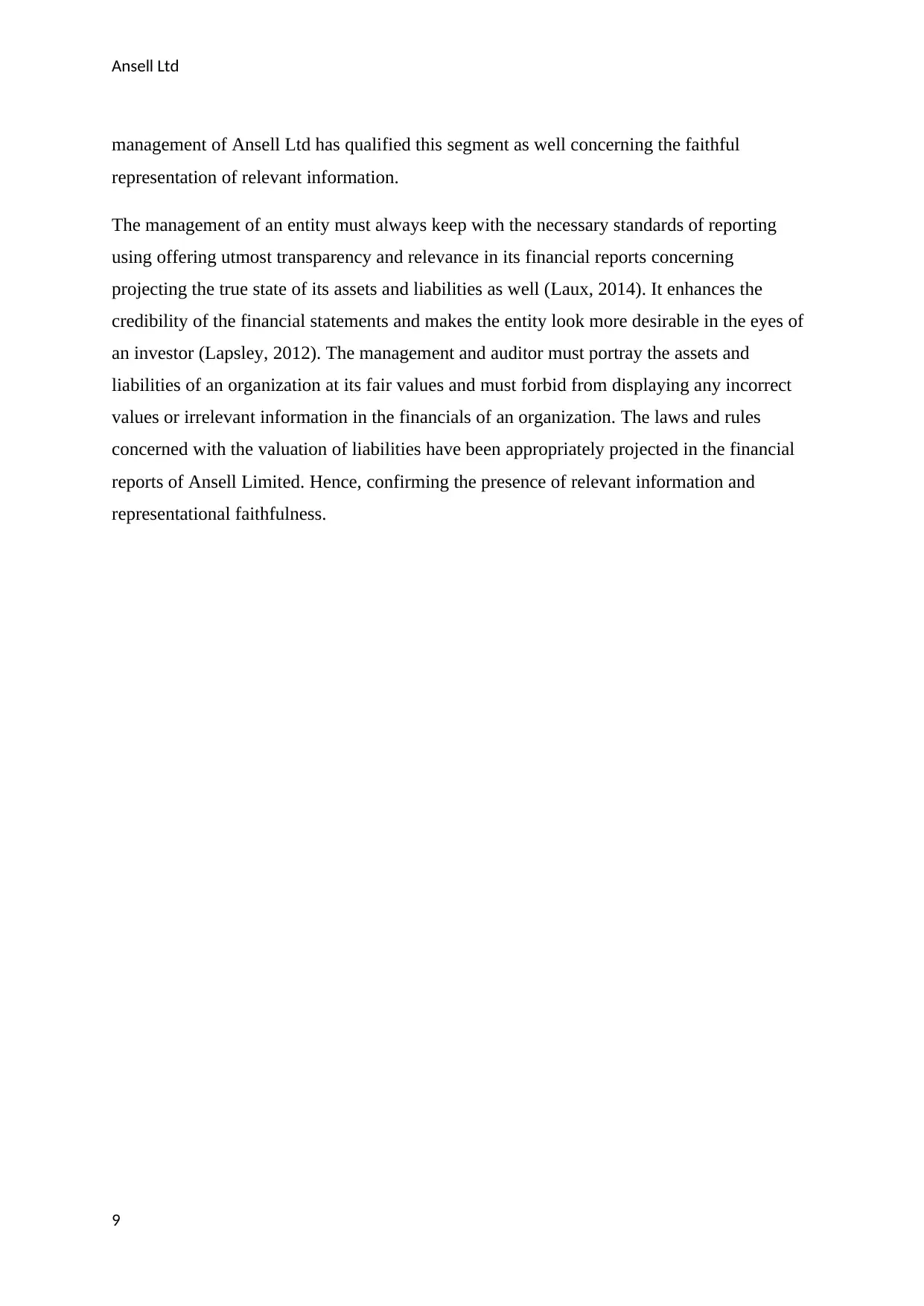
Ansell Ltd
management of Ansell Ltd has qualified this segment as well concerning the faithful
representation of relevant information.
The management of an entity must always keep with the necessary standards of reporting
using offering utmost transparency and relevance in its financial reports concerning
projecting the true state of its assets and liabilities as well (Laux, 2014). It enhances the
credibility of the financial statements and makes the entity look more desirable in the eyes of
an investor (Lapsley, 2012). The management and auditor must portray the assets and
liabilities of an organization at its fair values and must forbid from displaying any incorrect
values or irrelevant information in the financials of an organization. The laws and rules
concerned with the valuation of liabilities have been appropriately projected in the financial
reports of Ansell Limited. Hence, confirming the presence of relevant information and
representational faithfulness.
9
management of Ansell Ltd has qualified this segment as well concerning the faithful
representation of relevant information.
The management of an entity must always keep with the necessary standards of reporting
using offering utmost transparency and relevance in its financial reports concerning
projecting the true state of its assets and liabilities as well (Laux, 2014). It enhances the
credibility of the financial statements and makes the entity look more desirable in the eyes of
an investor (Lapsley, 2012). The management and auditor must portray the assets and
liabilities of an organization at its fair values and must forbid from displaying any incorrect
values or irrelevant information in the financials of an organization. The laws and rules
concerned with the valuation of liabilities have been appropriately projected in the financial
reports of Ansell Limited. Hence, confirming the presence of relevant information and
representational faithfulness.
9
⊘ This is a preview!⊘
Do you want full access?
Subscribe today to unlock all pages.

Trusted by 1+ million students worldwide
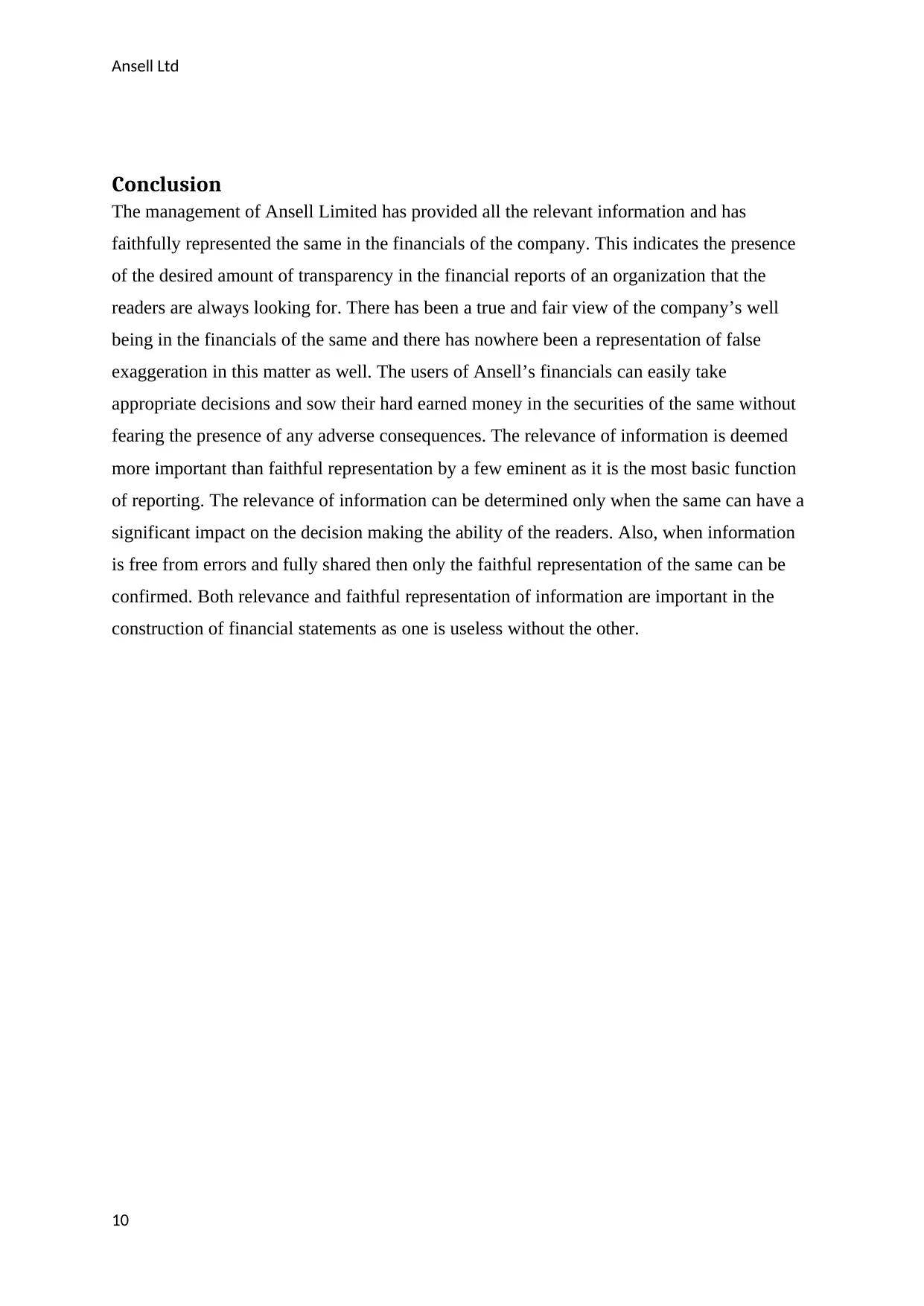
Ansell Ltd
Conclusion
The management of Ansell Limited has provided all the relevant information and has
faithfully represented the same in the financials of the company. This indicates the presence
of the desired amount of transparency in the financial reports of an organization that the
readers are always looking for. There has been a true and fair view of the company’s well
being in the financials of the same and there has nowhere been a representation of false
exaggeration in this matter as well. The users of Ansell’s financials can easily take
appropriate decisions and sow their hard earned money in the securities of the same without
fearing the presence of any adverse consequences. The relevance of information is deemed
more important than faithful representation by a few eminent as it is the most basic function
of reporting. The relevance of information can be determined only when the same can have a
significant impact on the decision making the ability of the readers. Also, when information
is free from errors and fully shared then only the faithful representation of the same can be
confirmed. Both relevance and faithful representation of information are important in the
construction of financial statements as one is useless without the other.
10
Conclusion
The management of Ansell Limited has provided all the relevant information and has
faithfully represented the same in the financials of the company. This indicates the presence
of the desired amount of transparency in the financial reports of an organization that the
readers are always looking for. There has been a true and fair view of the company’s well
being in the financials of the same and there has nowhere been a representation of false
exaggeration in this matter as well. The users of Ansell’s financials can easily take
appropriate decisions and sow their hard earned money in the securities of the same without
fearing the presence of any adverse consequences. The relevance of information is deemed
more important than faithful representation by a few eminent as it is the most basic function
of reporting. The relevance of information can be determined only when the same can have a
significant impact on the decision making the ability of the readers. Also, when information
is free from errors and fully shared then only the faithful representation of the same can be
confirmed. Both relevance and faithful representation of information are important in the
construction of financial statements as one is useless without the other.
10
Paraphrase This Document
Need a fresh take? Get an instant paraphrase of this document with our AI Paraphraser
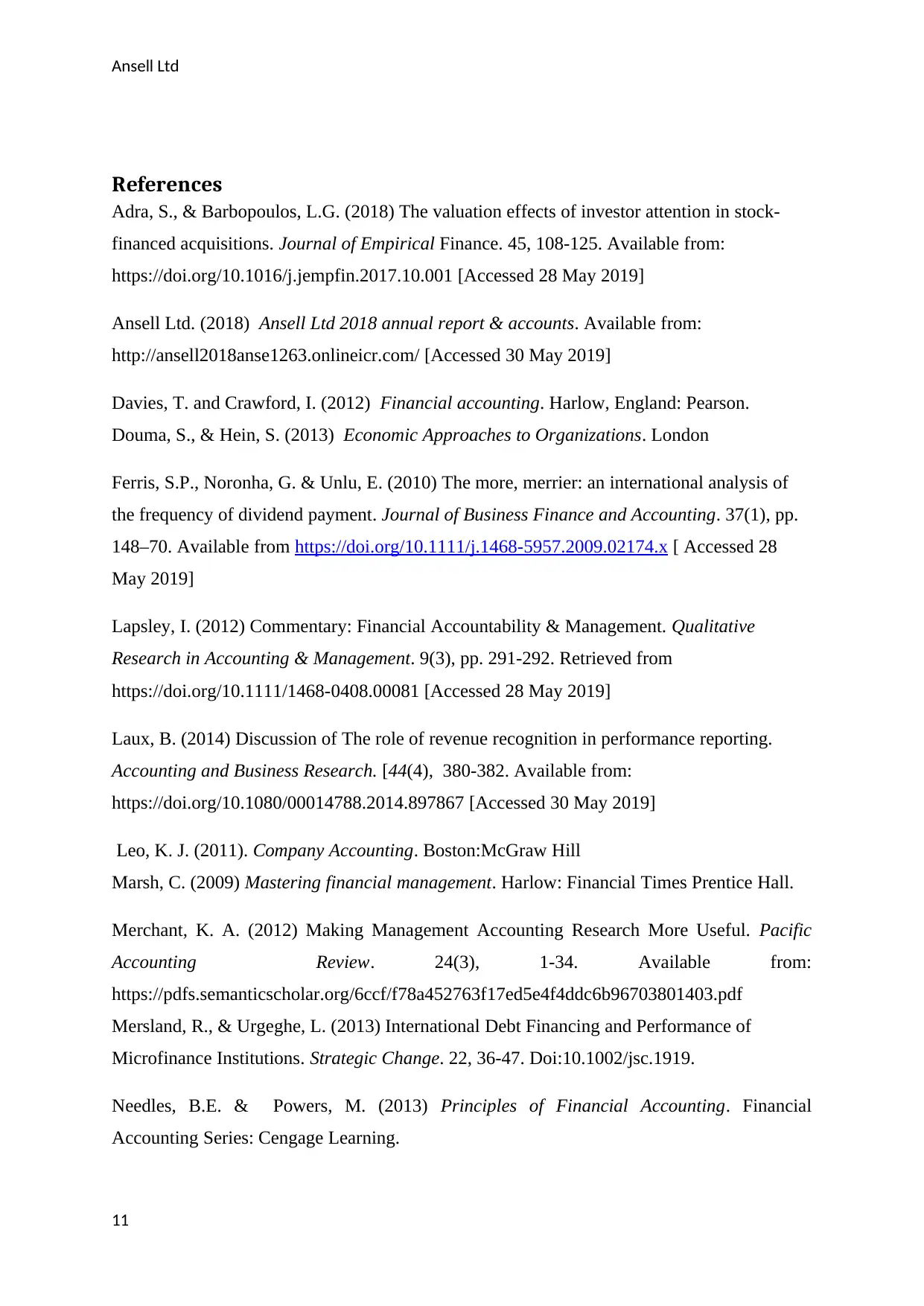
Ansell Ltd
References
Adra, S., & Barbopoulos, L.G. (2018) The valuation effects of investor attention in stock-
financed acquisitions. Journal of Empirical Finance. 45, 108-125. Available from:
https://doi.org/10.1016/j.jempfin.2017.10.001 [Accessed 28 May 2019]
Ansell Ltd. (2018) Ansell Ltd 2018 annual report & accounts. Available from:
http://ansell2018anse1263.onlineicr.com/ [Accessed 30 May 2019]
Davies, T. and Crawford, I. (2012) Financial accounting. Harlow, England: Pearson.
Douma, S., & Hein, S. (2013) Economic Approaches to Organizations. London
Ferris, S.P., Noronha, G. & Unlu, E. (2010) The more, merrier: an international analysis of
the frequency of dividend payment. Journal of Business Finance and Accounting. 37(1), pp.
148–70. Available from https://doi.org/10.1111/j.1468-5957.2009.02174.x [ Accessed 28
May 2019]
Lapsley, I. (2012) Commentary: Financial Accountability & Management. Qualitative
Research in Accounting & Management. 9(3), pp. 291-292. Retrieved from
https://doi.org/10.1111/1468-0408.00081 [Accessed 28 May 2019]
Laux, B. (2014) Discussion of The role of revenue recognition in performance reporting.
Accounting and Business Research. [44(4), 380-382. Available from:
https://doi.org/10.1080/00014788.2014.897867 [Accessed 30 May 2019]
Leo, K. J. (2011). Company Accounting. Boston:McGraw Hill
Marsh, C. (2009) Mastering financial management. Harlow: Financial Times Prentice Hall.
Merchant, K. A. (2012) Making Management Accounting Research More Useful. Pacific
Accounting Review. 24(3), 1-34. Available from:
https://pdfs.semanticscholar.org/6ccf/f78a452763f17ed5e4f4ddc6b96703801403.pdf
Mersland, R., & Urgeghe, L. (2013) International Debt Financing and Performance of
Microfinance Institutions. Strategic Change. 22, 36-47. Doi:10.1002/jsc.1919.
Needles, B.E. & Powers, M. (2013) Principles of Financial Accounting. Financial
Accounting Series: Cengage Learning.
11
References
Adra, S., & Barbopoulos, L.G. (2018) The valuation effects of investor attention in stock-
financed acquisitions. Journal of Empirical Finance. 45, 108-125. Available from:
https://doi.org/10.1016/j.jempfin.2017.10.001 [Accessed 28 May 2019]
Ansell Ltd. (2018) Ansell Ltd 2018 annual report & accounts. Available from:
http://ansell2018anse1263.onlineicr.com/ [Accessed 30 May 2019]
Davies, T. and Crawford, I. (2012) Financial accounting. Harlow, England: Pearson.
Douma, S., & Hein, S. (2013) Economic Approaches to Organizations. London
Ferris, S.P., Noronha, G. & Unlu, E. (2010) The more, merrier: an international analysis of
the frequency of dividend payment. Journal of Business Finance and Accounting. 37(1), pp.
148–70. Available from https://doi.org/10.1111/j.1468-5957.2009.02174.x [ Accessed 28
May 2019]
Lapsley, I. (2012) Commentary: Financial Accountability & Management. Qualitative
Research in Accounting & Management. 9(3), pp. 291-292. Retrieved from
https://doi.org/10.1111/1468-0408.00081 [Accessed 28 May 2019]
Laux, B. (2014) Discussion of The role of revenue recognition in performance reporting.
Accounting and Business Research. [44(4), 380-382. Available from:
https://doi.org/10.1080/00014788.2014.897867 [Accessed 30 May 2019]
Leo, K. J. (2011). Company Accounting. Boston:McGraw Hill
Marsh, C. (2009) Mastering financial management. Harlow: Financial Times Prentice Hall.
Merchant, K. A. (2012) Making Management Accounting Research More Useful. Pacific
Accounting Review. 24(3), 1-34. Available from:
https://pdfs.semanticscholar.org/6ccf/f78a452763f17ed5e4f4ddc6b96703801403.pdf
Mersland, R., & Urgeghe, L. (2013) International Debt Financing and Performance of
Microfinance Institutions. Strategic Change. 22, 36-47. Doi:10.1002/jsc.1919.
Needles, B.E. & Powers, M. (2013) Principles of Financial Accounting. Financial
Accounting Series: Cengage Learning.
11
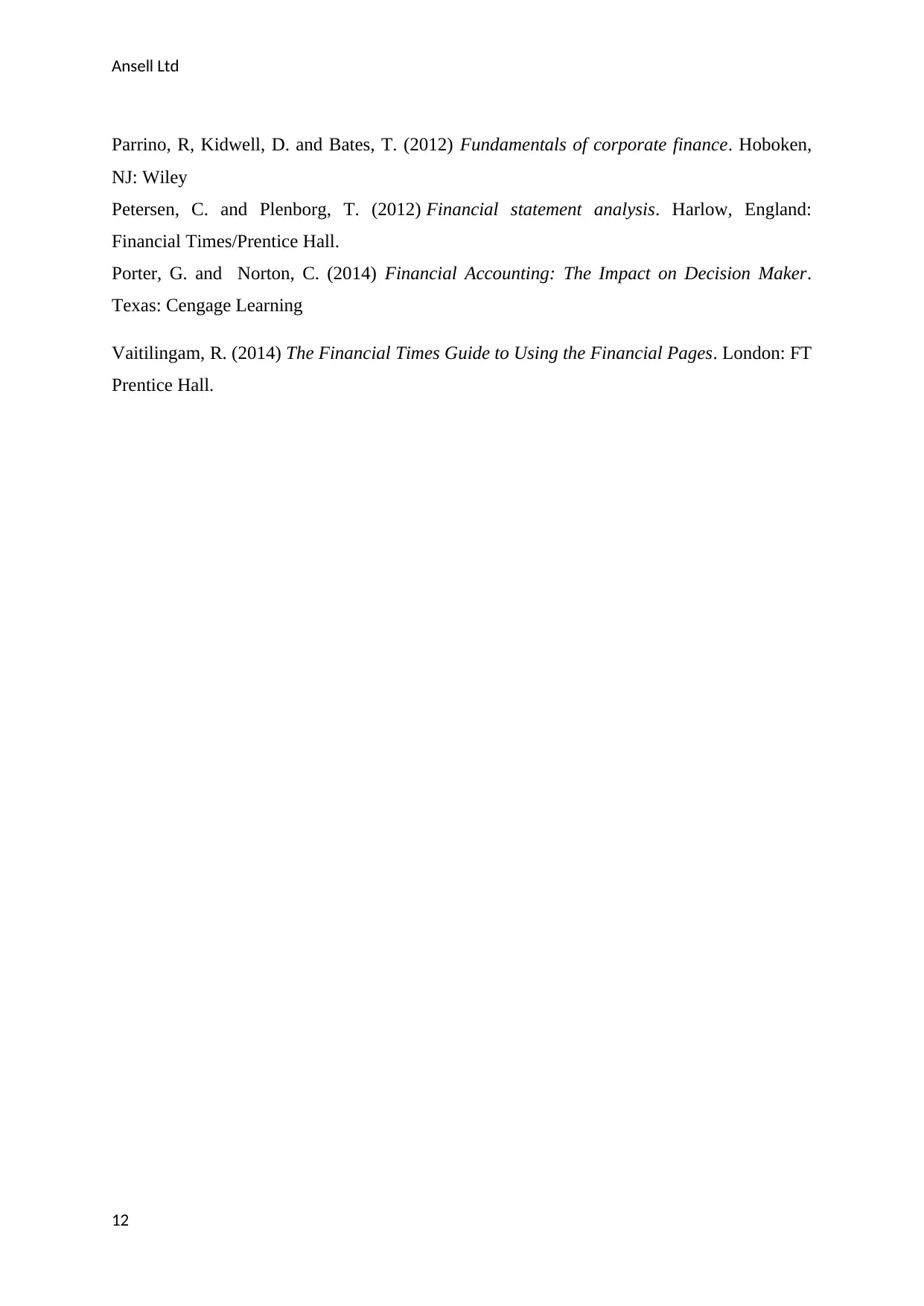
Ansell Ltd
Parrino, R, Kidwell, D. and Bates, T. (2012) Fundamentals of corporate finance. Hoboken,
NJ: Wiley
Petersen, C. and Plenborg, T. (2012) Financial statement analysis. Harlow, England:
Financial Times/Prentice Hall.
Porter, G. and Norton, C. (2014) Financial Accounting: The Impact on Decision Maker.
Texas: Cengage Learning
Vaitilingam, R. (2014) The Financial Times Guide to Using the Financial Pages. London: FT
Prentice Hall.
12
Parrino, R, Kidwell, D. and Bates, T. (2012) Fundamentals of corporate finance. Hoboken,
NJ: Wiley
Petersen, C. and Plenborg, T. (2012) Financial statement analysis. Harlow, England:
Financial Times/Prentice Hall.
Porter, G. and Norton, C. (2014) Financial Accounting: The Impact on Decision Maker.
Texas: Cengage Learning
Vaitilingam, R. (2014) The Financial Times Guide to Using the Financial Pages. London: FT
Prentice Hall.
12
⊘ This is a preview!⊘
Do you want full access?
Subscribe today to unlock all pages.

Trusted by 1+ million students worldwide
1 out of 12
Related Documents
Your All-in-One AI-Powered Toolkit for Academic Success.
+13062052269
info@desklib.com
Available 24*7 on WhatsApp / Email
![[object Object]](/_next/static/media/star-bottom.7253800d.svg)
Unlock your academic potential
Copyright © 2020–2025 A2Z Services. All Rights Reserved. Developed and managed by ZUCOL.





